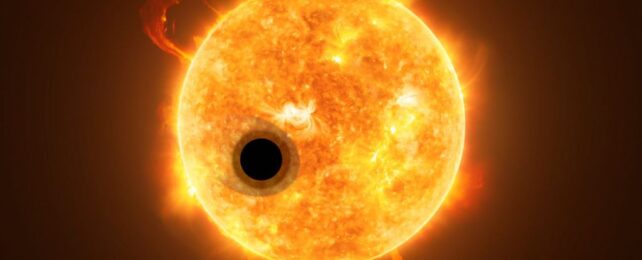A mysterious exoplanet just 138 light-years from Earth could be in the process of transforming.
An analysis of an exoplanet named HD-207496b reveals that the world, clocking in at 6.1 and 2.25 times the mass and radius of Earth, respectively, either has a gaseous atmosphere, a global ocean, or a mixture of both – and it could be shrinking down to become a super-Earth.
This could help astronomers resolve a mystery in exoplanet detections, a gap between the masses of rocky planets bigger than Earth and gaseous planets smaller than Neptune. But it will take a closer look at the enigmatic exoplanet to characterize its atmosphere.
It's a diverse galaxy out there, with many very different exoplanets. Astronomers have discovered and confirmed around 5,300 worlds outside the Solar System at the time of this writing, with nearly twice that many unconfirmed candidates.
With this information, scientists can conduct statistical analyses to figure out trends in planetary systems. And one interesting thing we've learned is that there is a glaring scarcity of exoplanets between 1.5 and 2 times the mass of Earth with orbits shorter than around 100 days.
This is known as the small planet radius valley. Below it, we generally find rocky worlds like Earth, Venus, and Mars; we call them super-Earths.
Above it, we find worlds with thick atmospheres, like miniature Neptunes, and we call them mini-Neptunes.
The reasons for the valley aren't entirely clear, but a growing body of evidence is beginning to suggest that close proximity to the host star has something to do with it. It's possible that below a certain critical threshold, an exoplanet just doesn't have enough mass to keep a gravitational grip on its atmosphere (the gas is evaporated by the star's radiation).
We've detected a few worlds that contain clues about this process, and scientists are looking for more, using the High Accuracy Radial Velocity Planet Searcher (HARPS) on the European Southern Observatory's 3.6-meter telescope at La Silla Observatory in Chile, following up on candidates identified by NASA's space-based exoplanet-hunting telescope TESS.
This is what brought an international team led by astrophysicist Susana Barros of the University of Porto in Portugal to HD-207496b.
TESS looks for exoplanets by staring at a patch of sky, its sensitive instruments tuned to the very faint dips in starlight that could be evidence of an orbiting exoplanet passing, or transiting, between us and the star.
If these transits occur with regularity, astronomers can easily infer the presence of an orbiting body and determine its period.
If the star's brightness is known, the depth of the transit dips – how much starlight is blocked – allows astronomers to calculate the radius of the orbiting body.
HARPS detects another metric. As an exoplanet orbits with a star, it exerts a gravitational pull of its own. The exoplanet doesn't, technically, orbit the star; rather, the two bodies orbit a mutual center of mass, known as the barycenter. Because stars are so much more massive than their worlds, they don't move much, instead just wiggling about on the spot minutely.
This is what HARPS can measure. As the star wiggles towards and away from us, the wavelength of its light changes, compressing when the star moves closer and stretching as the star moves away. How much the star moves depends on the exoplanet's mass, so astronomers can calculate that, too.
Once you know the mass and radius of an exoplanet, you can put them together to calculate its density. This is where it gets really interesting because density can be used to infer what the exoplanet is made of.
When TESS picked up an exoplanet close to the radius valley, with a radius 2.25 times that of Earth and an orbit of 6.44 days with an orange dwarf star named HD-207496, they took to HARPS for a closer look. The HARPS data revealed that HD-207496b has a mass about 6.1 times that of Earth.
That means the exoplanet's density is around 3.27 grams per cubic centimeter. That's considerably less dense than Earth's 5.51 grams per cubic centimeter and implies that the composition of HD-207496b is not entirely rocky. So the researchers performed modeling to see what the world is made of.
"We find that HD-207496b has a density lower than Earth, and hence we expect that it has a significant amount of water and/or gas in its composition," the researchers write in their paper. "From internal structure modeling of the planet, we conclude that the planet has either a water-rich envelope, a gas-rich envelope, or a mixture of both."
Evaporation modeling reveals that if the exoplanet has a gas-rich atmosphere of hydrogen and helium, that state is temporary: The star will strip the exoplanet completely within 520 million years. It's also possible that the atmosphere has already gone, and HD-207496b is already a bare ocean world.
"In general," the researchers write, "we expect that the planet would have both water and a H/He envelope and be in between both these models."
The star, HD-207496, is relatively young, around 520 million years old. That means it represents a rare opportunity to study the youth of one of these exoplanets before transformation to a bare super-Earth, if that is indeed in store for HD-207496b.
Follow-up studies to characterize the atmosphere, if there is one, should reveal the true nature – and ultimate fate – of this mysterious world.
The research has been accepted in Astronomy & Astrophysics and is available on arXiv.
